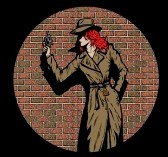Because what we do is public we are Public (not private) investigators.
Because what we do is interdisciplinary we are not just public historians… we are Investigators.
Andrew Ross has famously framed the work of American studies (or at least his work) as “scholarly reportage,” by which he means the “blending of ethnography and investigative journalism.” In a sense we are asking the critical questions of our times and using whatever methods and tools we can get our hands on the answers to them.
I would push this “scholarly reportage” idea a bit further and argue what we can do really well in American studies is to be PIs… the public private investigators. So, what does that mean? A lot. To start, there are three general rules I want to begin with for the AMST PI. Before jumping into what we will be doing specifically in AMST 422/680 during the spring 2014 semester, we need to brush up on the basics.
American studies PIs must be willing to…
- READ… all the time and the right things. To develop a critical eye for contemporary issues that matter, you must read actively, critically, and often. You must read from various perspectives and always with a skeptical eye… the public/private eye.
- WRITE… well. Number 2 is directly connected to number 1. To write well you must first be a good critical reader. And you must realize that 80% of writing is editing. Write, read, and rewrite/edit… until the deadline.
- TAKE RISKS… what trails will we follow to get the story? We may end up with dirty hands in some community garden or stepping on a rat in some Baltimore alley… we may end up in a nice lady’s living room with some cookies and milk or lost for hours in an awesome archive. You never know where a case will take you. To be an AMST PI you must be willing to take risks but not stupid risks (of course, don’t put yourself in actual danger…ever). You must be willing to take intellectual risks and to “meet people where they are” [Andrew Ross, again]. Get out of the classroom, okay?
I frame our job in AMST 422/680 as AMST PIs not because I love long acronyms but because I truly believe the research process is a fun and exciting adventure of discovery. The private investigator seeks out the clues, stories, and missing links that solve the case and so do we. Yet with cultural history the case is never solved; it’s always ongoing. We seek the riveting tales of environmental history in Baybrook… not just the existing neighborhood of Brooklyn and Curtis Bay, but also the mysterious and illusive “lost neighborhoods” of Fairfield, Wagner’s Point, and, in the most southern tip of Baltimore City, Hawkin’s Point. We strive to understand the past, act in the present, and envision the futures (yes, plural).
The general public may not necessarily think of an industrial community as having an important environmental history. That’s why us AMST PIs are needed—to help the public see what’s missing, overlooked, and lurking just below the surface. Baybrook has a long and complicated relationship with green space—the parks, waters, natural environments, and community gardens. The stories we find may also have a darker side—tales of unhinged industrial development, pollution, and even environmental disasters. The environmental history of Baybrook is as complicated as it is rich. We must always remember that we work for the community we are researching. It is their story—we are just on the case for a semester—and we must follow their lead. While private investigators usually have a single client, our client is plural. Our client is the comprehensive community—past, present, and future.
The stories of industrial workers and residents are often overlooked for sweeping tales of big business and big bucks. I find that story—the boom and bust of U.S. industry—a bit tired (it’s been told) and boring. I want to know what the people are saying in the bars, the living rooms, the backyards, and on the streets. This desire to know what people are really thinking begins to blur the distinction between the public and the private, which is a good place for the AMST public/private investigator—the liminal space between what’s public and what’s private.
We are working in the tradition of Sam Spade, Charlie’s Angels, Tess Monaghan, and other popular culture icons. Remember that research is fun and exciting business and you should find the things that interest you… the things you are curious, even obsessed, about. Most importantly, remember you are working to do justice to the actual stories of a real community on the southern tip of Baltimore City. Now get to work AMST PIs. What are the questions? What are the stories?
